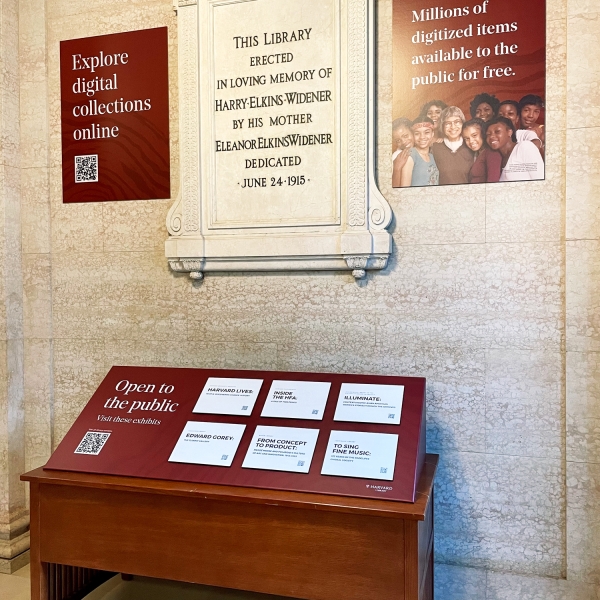Highlights
Harvard Library’s flagship location, Widener Library offers inspiring study spaces, miles of stacks to explore, and friendly librarians ready to help.
- 450 languages collected
- 6 million+ items digitized
- Home to a Gutenberg Bible
- Host of CS50 & HUM10 classes
Accessibility of Widener Library
- The Mass Ave. entrance to Widener Library is accessible by automatic door. You can access all floors of the building via elevator.
- There is an accessible workstation with Zoomtext and JAWS software installed in Room 180 on the first floor. The Atkins Reading Room on the second floor has an adjustable height desk.
- There is an accessible, all-gender restroom on the ground floor of Widener Library, near the Mass Ave entrance.There are two accessible single-use, all-gender restrooms on the 2nd floor.
Contact Widener Access Services staff member, Francesca Giacchino, fgiacch@fas.harvard.edu, with questions about accessibility of elevators, study spaces, and restrooms.
Widener Resources
What's Happening
Collections
History
The Harry Elkins Widener Memorial Library is Harvard University's flagship library.
Built with a gift from Eleanor Elkins Widener, the library is a memorial to her son, Harry, Class of 1907. Harry was an enthusiastic young bibliophile who perished aboard the Titanic.
It had been Harry's plan to donate his personal collection to the University once it provided a suitable alternative to the outdated and inadequate library then located in Gore Hall. Mrs. Widener fulfilled her son's dream by building a facility of monumental proportions, with over 50 miles of shelves and the capacity to hold over three million volumes.
The library opened in 1915, but Harvard's collections continued to grow at an astounding rate. By the late 1930s, Widener's shelves were at capacity. Space was at a premium for staff and patrons as well as books, which led the administration to begin a lengthy decentralization process.
Over time Harvard built several new libraries to house its increasingly specialized collections. By redistributing books to new libraries, space opened up in Widener, but it was gradually given over to the growing staff hired to attend to the collections.
In addition to the physical challenges associated with housing and maintaining an ever growing collection, the 20th century also saw technological advancements that affected Widener--from electrical wiring to a computerized card catalog to sophisticated research workstations.
Widener Library ushered in the new millennium in the midst of its greatest change since opening in 1915. From 1999 to 2004, the building underwent extensive renovations to ensure the long-term preservation and security of collections, and to increase user space.
For more in-depth information about Widener's history, see:
- The online exhibition History of the Harry Elkins Widener Memorial Collection
- Widener: Biography of a Library by Matthew Battles, Harvard University Press, 2004
